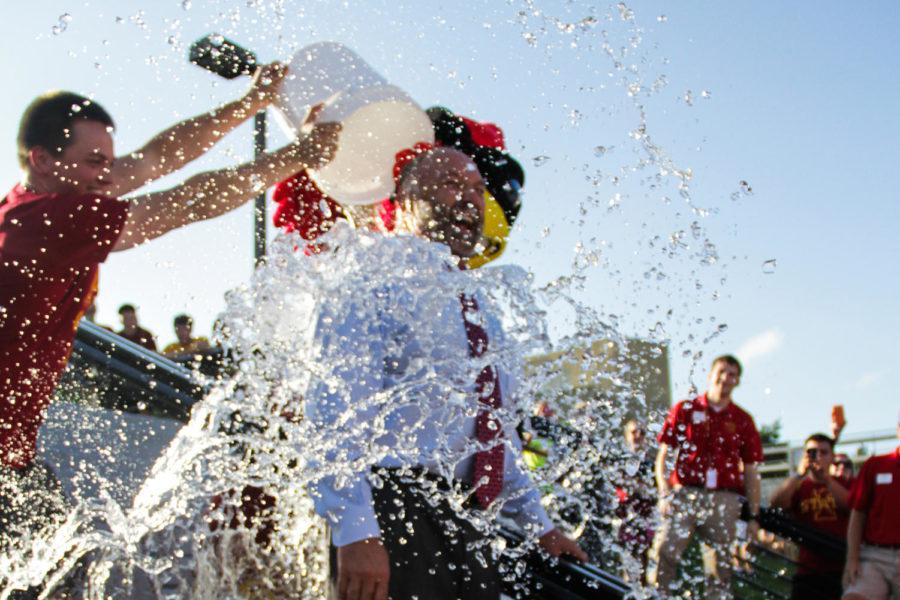Mueller: Find ways to raise ALS awareness as college students
ISU president Steven Leath was challenged by ISU senior Jacob Schaefer to the ALS Association’s Ice Bucket Challenge. Leath completed the challenge at Destination Iowa State on Aug. 21. Cy dumped a bucket of ice water on him.
August 25, 2014
The Internet has recently found a new sensation — the ALS Ice Bucket Challenge. The challenge has not only created a significant increase in donations but has also helped raise awareness of ALS.
ALS stands for amyotrophic lateral sclerosis, more commonly known as Lou Gehrig’s disease. ALS is a lethal neurodegenerative disease that causes motor neurons to die, which leads to loss of control of muscle movement.
There is currently no cure for ALS, nor is there any treatment available to reverse the effects of the disease. According to the ALS Association website, however, there is one Food and Drug Administration-approved drug available that helps slow the progression of the disease.
So where did the connection between the challenge and ALS fundraising happen? ESPN reports that Pete Frates of Boston is “credited with creating the challenge along with friend and fellow ALS patient Pat Quinn.”
In spring 2012, Frates, a former Boston College baseball player, was diagnosed with ALS and decided to take action. In summer 2014, Frates took to Facebook, nominating friends to take a video of themselves pouring a bucket of ice water on their heads and post it on social media as a means to raise awareness.
The rules of the ALS Ice Bucket Challenge are as follows: upon nomination, people have 24 hours to douse themselves with a bucket of ice water. If they fail to complete the challenge, they donate $100 to an ALS charity.
The videos soon caught the attention of athletes all over the Boston area. Eventually, athletes all over the nation began participating in the challenge. The challenge initially was a gesture to raise awareness and quickly became a fundraiser.
The movement did not end with athletes, however. It seemed as if countless actors, actresses, writers, musicians, politicians, billionaires and everyday folk alike were posting videos for the ALS Ice Bucket Challenge overnight.
With the vast increase of popularity among the videos, it was clear that people were dumping the water on their heads. But a dumped bucket was the way to opt out on donations. Because of that, the ALS Ice Bucket Challenge started to gain a lot of disapproval as well.
It is however a misconception that people continue participating without donating. Frates did not start the challenge with the donation clause attached. The donation aspect was added on somewhere down the line and that rule stuck around.
Celebrities like Zachary Quinto, Taylor Swift, Carey Hart and Troian Bellisario have spoken out about the necessity to donate as well. Swift completed the challenge while also donating $100 on her behalf as well as $100 each for all the people participating in her video. Hart commented on his Instagram that he took the donation route, saving the water.
Since California is in the middle of a drought, Bellisario not only participated but also had a tip for future participants — share your water. She went on to nominate three others, including Quinto.
Quinto went one step further than Bellisario by donating instead of participating. He wrote on his Instagram, “in light of the staggering drought in California and the desperate need for clean drinking water in developing countries, I opt for donating directly to project ALS in lieu of an ice bucket challenge.”
New trends regarding the challenge are forming daily. However, the donations are coming in as well. The New York Times wrote that the ALS Association “had received $41.8 million in donations from July 29 until Aug. 21.”
The Times further stated that with the 739,000 new donors, contributions from July and August alone are “more than double the $19.4 million in total contributions the association received during the year that ended Jan. 31, 2013.”
Personally, I have seen my peers start the challenge within the past couple of days. It is discouraging but understanding to hear people so happily pour the bucket instead of donating the $100. Being college students, we are not always fiscally able to donate $100 when that money is needed for books, groceries or rent.
However, I urge my fellow peers to take action another way. The challenge has been evolving, so why not have a different option for college students? I propose that we not only participate but also fully educate ourselves on the cause. Learn about the disease, donate that $5 sitting on your dresser, go door-to-door canning for donations.
The ALS Ice Bucket Challenge began with hopes of widespread awareness and that’s the least we can do. Whether you donate more or less than the $100, drench yourself in freezing water or donate and participate, there is a lot you can do for very little. The key is to get moving.

















